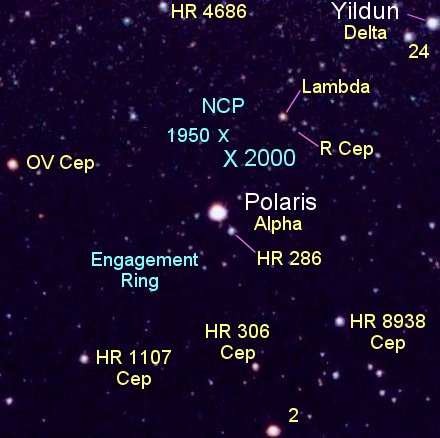POLARIS, POLAR STARS, AND PRECESSION
 Second magnitude Polaris, Alpha Ursae Minoris, of
Ursa Minor (at the end of the handle of the Little Dipper) is
smack in the middle of the picture, which is 6.0 degrees across. Star names
without constellation abbreviations attached are in Ursa Minor. Yildun,
Delta UMi, is the bright star at upper right.
The ragged circle of faint stars down and to the left of Polaris is
called the "Engagement Ring," with of course Polaris as its shining stone.
Second magnitude Polaris, Alpha Ursae Minoris, of
Ursa Minor (at the end of the handle of the Little Dipper) is
smack in the middle of the picture, which is 6.0 degrees across. Star names
without constellation abbreviations attached are in Ursa Minor. Yildun,
Delta UMi, is the bright star at upper right.
The ragged circle of faint stars down and to the left of Polaris is
called the "Engagement Ring," with of course Polaris as its shining stone.
Polaris is right at mid-second magnitude(2.02), while
the faintest stars in the picture are 10th.
With the exception of
9th magnitude (8.5) R Cephei (which is actually in Ursa Minor),
labelled stars are all
brighter than apparent magnitude 6.5.
Lambda (magnitude 6.4) and HR 286 (6.5) are both
near this approximate limit of naked-eye vision.
The North Celestial Pole (NCP) for the year 2000 is marked with a large "X,"
while that for the year 1950 is marked with a small "x," showing the
effect of
precession (the 26,000-year wobble of the Earth's axis),
which is making Polaris an ever-better pole star. Now just under
3/4 of a degree (45 minutes of arc) away, the NCP will pass
only 27 minutes of arc from Polaris in the year 2100.
 Second magnitude Polaris, Alpha Ursae Minoris, of
Ursa Minor (at the end of the handle of the Little Dipper) is
smack in the middle of the picture, which is 6.0 degrees across. Star names
without constellation abbreviations attached are in Ursa Minor. Yildun,
Delta UMi, is the bright star at upper right.
The ragged circle of faint stars down and to the left of Polaris is
called the "Engagement Ring," with of course Polaris as its shining stone.
Second magnitude Polaris, Alpha Ursae Minoris, of
Ursa Minor (at the end of the handle of the Little Dipper) is
smack in the middle of the picture, which is 6.0 degrees across. Star names
without constellation abbreviations attached are in Ursa Minor. Yildun,
Delta UMi, is the bright star at upper right.
The ragged circle of faint stars down and to the left of Polaris is
called the "Engagement Ring," with of course Polaris as its shining stone.